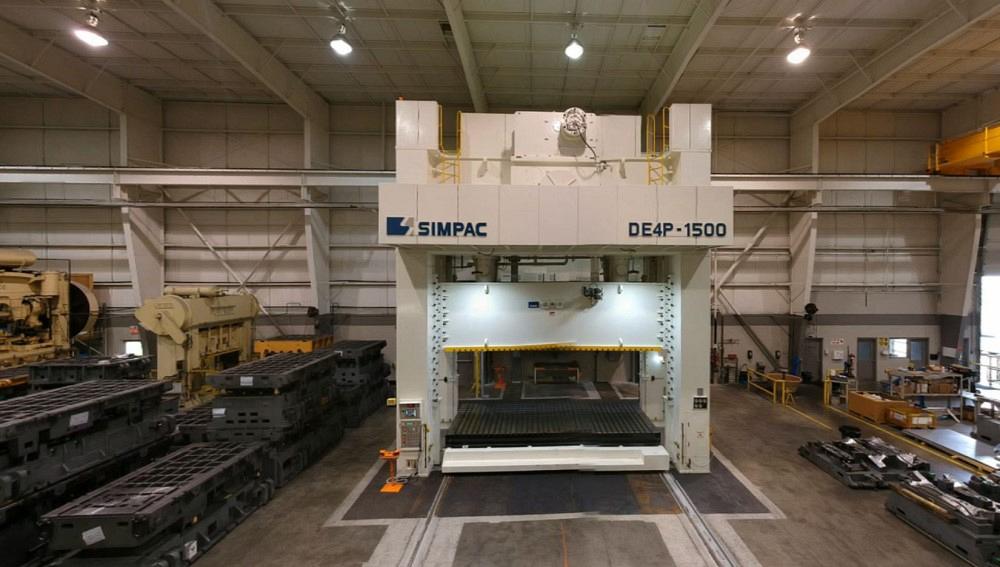General Manager/VP Sales and Operations
- FMA
- The Fabricator
- FABTECH
- Canadian Metalworking
Categories
- Additive Manufacturing
- Aluminum Welding
- Arc Welding
- Assembly and Joining
- Automation and Robotics
- Bending and Forming
- Consumables
- Cutting and Weld Prep
- Electric Vehicles
- En Español
- Finishing
- Hydroforming
- Laser Cutting
- Laser Welding
- Machining
- Manufacturing Software
- Materials Handling
- Metals/Materials
- Oxyfuel Cutting
- Plasma Cutting
- Power Tools
- Punching and Other Holemaking
- Roll Forming
- Safety
- Sawing
- Shearing
- Shop Management
- Testing and Measuring
- Tube and Pipe Fabrication
- Tube and Pipe Production
- Waterjet Cutting
Industry Directory
Webcasts
Podcasts
FAB 40
Advertise
Subscribe
Account Login
Search
Stay with mechanical or go to servo? That's the question for metal stampers
Materials, part complexity, cost are determinants for metal manufacturers
- By Stephan Robertson
- June 23, 2022
- Article
- Bending and Forming

Determining whether your next press installation will be a modern mechanical or a servo mechanical can be difficult. Materials, part complexity, and cost are factors, and automation and dies are important considerations.
As manufacturing progresses through the 21st century, stamping manufacturers keep on searching for a better mousetrap that will help them be more efficient and effective today and in the future.
When you are looking at purchasing a new press and are trying to decide between an eccentric-gear or link-drive mechanical press or a servo mechanical press, many things must be taken into consideration. You should first look at what types of materials are being stamped and the run times needed. Considerations might involve tight tolerances and the complexity of the parts. Your operation might require more automation than you have, or remote operation. Perhaps the most important factor is cost and your budget.
While a place for traditional mechanical press technologies will exist in this new age, servo technologies are starting to become more of a necessity for certain stamping manufacturing operations. In other cases, a mechanical press will do the job well. Both standard mechanical and servo press technologies offer benefits in future press shops.
When a Mechanical Press Is Sufficient
Materials. As the world pushes more toward electric vehicles and renewable energy, high-strength, advanced, and exotic materials are becoming more prevalent in manufacturing processes.
No matter how big or small your shop is, if you are running simple, cold-rolled steel, aluminum with a Class II or Class III surface requirement, or high-strength steels up to 950 MPa, then you might want to look first at a modern standard mechanical press.
Part Complexity. Whether you are stamping flat parts or adding a small draw to the material with accompanying concerns about springback or breakthrough shock, a new mechanical press could be the way to go.
Speed. Mechanical presses are the fastest for applications requiring full torque at maximum speeds. Servo presses are equipped with mechanisms to gain speed, but for long runs and simple parts, mechanical presses have a speed advantage.
Cost, Budget, ROI. Finally, and not the least important (especially from a purchasing point of view) is the price of your new press. Currently, mechanical presses are still cheaper to purchase than a servo press. That can be a huge benefit to your bottom line in the short run.
If you don’t need the extra flexibility of a servo press, you are stamping relatively basic parts, and the part families that you are running are all the same or very similar, then a servo press may not gain you a good return on investment (ROI).
When a Servo Press Is Best
Materials. For operations that are stamping high-strength materials above 950 MPa or other specialty steels, Class I surfaces, or multiple jobs requiring several die changes per day, then adding a servo press to your fleet of presses is recommended.

Both the standard eccentric-gear and link-drive mechanical presses and newer servo technologies offer benefits in future press shops
Part Complexity. If you are stamping multiple different part families in which a large variation in the press curve is required, then a servo press offers the flexibility to get this done. By having control of not just the downstroke but also the dwell time at bottom dead center, and being able to accelerate on the upstroke, you can speed up the operations. One of the big benefits of a servo press is to be able to preprogram specialty curves for multiple part families with different strokes. In that way, a servo press provides definite advantages that a link-drive press does not.
Speed. A servo press offers better control of the ram speed. This is especially important when stamping the specialty materials that are used today for the new generations of vehicles.
Cost, Budget, ROI. Yes, servo presses and the large servo motors they are equipped with are more expensive. Yes, you will be looking at different and potentially more expensive die technologies, and, yes, a specific type of training is required for your workforce to run a servo press properly. However, based solely on the advanced materials that are coming onto the market coupled with the need for a higher throughput, a servo press can be worth the higher initial purchase price.
True for Servo and Mechanical
Tolerances.
Many new parts are requiring tighter tolerances. Either a next-generation mechanical press or a servo press can give you the tolerances that you are looking for.Automation. A factor that you should take into consideration when deciding on a new press purchase is the automation technology. Whether you decide on a mechanical or servo press, automation will help you increase your throughput.
It is very important to make sure that the automation technologies, such as a coil feeder or transfer equipment, can keep up with your press. It does no one any good if you purchase the latest and greatest press technology with a press that can go 60 to 80 strokes per minute (SPM) while the automation can only handle 30 SPM. Remember, the most expensive part of your investment is your press, and if anything is going to be the bottleneck, it should be the press and nothing else.
Dies. It is also important to note that the die technology will have to be changed and upgraded for a servo press if you are now running at a faster rate. This is common sense. Look for better-quality die materials, different types of coatings, or upgrade to nitrogen springs to your dies if you accelerate your operation. You won’t achieve the speeds you need if you use existing dies from presses that go 20 SPM in a press that goes 40 SPM. That is a recipe for disaster. Don’t expect those dies to last.
Whether you decide on a mechanical or servo mechanical press, common sense must prevail. A new press will help you improve your SPM, as long as you make sure that your dies and automation equipment can match the new speed requirements. That is essential to your envisioned new press output needs as well as improving your ROI.
About the Author

Related Companies
subscribe now

The Fabricator is North America's leading magazine for the metal forming and fabricating industry. The magazine delivers the news, technical articles, and case histories that enable fabricators to do their jobs more efficiently. The Fabricator has served the industry since 1970.
start your free subscription- Stay connected from anywhere

Easily access valuable industry resources now with full access to the digital edition of The Fabricator.

Easily access valuable industry resources now with full access to the digital edition of The Welder.

Easily access valuable industry resources now with full access to the digital edition of The Tube and Pipe Journal.
- Podcasting
- Podcast:
- The Fabricator Podcast
- Published:
- 04/16/2024
- Running Time:
- 63:29
In this episode of The Fabricator Podcast, Caleb Chamberlain, co-founder and CEO of OSH Cut, discusses his company’s...
- Trending Articles
AI, machine learning, and the future of metal fabrication

Employee ownership: The best way to ensure engagement

Steel industry reacts to Nucor’s new weekly published HRC price

Dynamic Metal blossoms with each passing year

Metal fabrication management: A guide for new supervisors

- Industry Events
16th Annual Safety Conference
- April 30 - May 1, 2024
- Elgin,
Pipe and Tube Conference
- May 21 - 22, 2024
- Omaha, NE
World-Class Roll Forming Workshop
- June 5 - 6, 2024
- Louisville, KY
Advanced Laser Application Workshop
- June 25 - 27, 2024
- Novi, MI


























